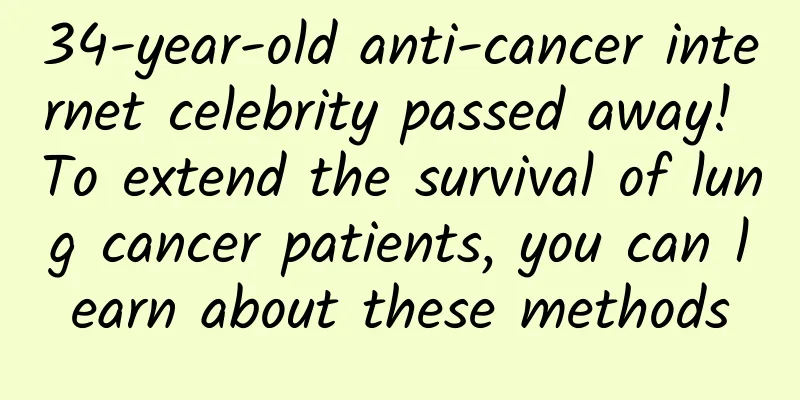34-year-old anti-cancer internet celebrity passed away! To extend the survival of lung cancer patients, you can learn about these methods

|
Recently, the hot search topic #34-year-old anti-cancer internet celebrity Li Xiaoniu died# caused many people to sigh. Previously, after she was diagnosed with cancer, she had been actively and optimistically accepting treatment, and bravely facing the challenges of fate. Her uncompromising spirit infected many netizens. Therefore, the number of her fans on the online platform continued to rise, and her anti-cancer process also attracted widespread attention. It is understood that in September 2021, "Li Xiaoniu" went to the hospital for examination due to sudden physical discomfort. She was eventually diagnosed with advanced lung cancer, with no chance of surgery, and accompanied by multiple bone metastases throughout the body. In April 2023, lung cancer metastasized to the meninges, and she died at 7:30 pm on December 1. From discovery to death, her survival period was only 2 years and 3 months. In recent years, the incidence and mortality of lung cancer have increased rapidly in countries around the world, especially in industrially developed countries. Lung cancer is currently the leading cause of cancer death in the world. In my country, the incidence of lung cancer in men is much higher than that in women, with a ratio of about 3:1. In recent years, the incidence of lung cancer in women has also increased significantly, and most patients are over 40 years old. Many patients diagnosed with lung cancer are very desperate because the disease is often difficult to detect in the early stages, and most are already in the middle and late stages when diagnosed, missing the best time for treatment. How to prolong the survival of lung cancer patients? How to improve the quality of life of patients with advanced lung cancer? How to improve the public's awareness of cancer screening and detect lung cancer early? These are problems that have plagued clinicians for a long time, and are also challenges facing the current development of medical technology. Chemotherapy has always been the main treatment for advanced lung cancer, but it has large adverse reactions. In order to get rid of the pain of chemotherapy and maximize the benefits for patients, people have been seeking new treatment options. With the continuous advancement of science and technology, the treatment of lung cancer is moving towards precision. Recently, a number of studies published at the World Lung Cancer Conference (WCLC) may confirm that combination therapies including dual-targeted therapy, immune + targeted, targeted + chemotherapy, and immune + chemotherapy have become a trend in the treatment of advanced lung cancer and can significantly prolong the survival of lung cancer patients. The research results are summarized as follows for your reference. 1. Dual targeted therapy: Research results show that the objective response rate of dual targeted therapy of Rybrevant + lazertinib in the treatment of advanced non-small cell lung cancer reached 50%, the median progression-free survival was 14 months, and 80% of patients had a response duration of more than 6 months. 2. Targeted combined immunotherapy: Research results show that the objective response rate of Trodelvy + Keytruda in the first-line treatment of advanced or metastatic non-small cell lung cancer is 56%, the disease control rate is 82%, and the 6-month disease control rate is 88%; among them, the objective response rate of lung cancer patients with programmed cell death-ligand 1 (PD-L1) tumor proportion score (TPS) ≥ 50% is 69%, and the disease control rate is 86%; the objective response rate of lung cancer patients with PD-L1 tumor TPS < 50% is 44%, and the disease control rate is 78%. The response rate of Enhertu + Imfinzi in the first-line treatment of advanced lung cancer is 50%, and the disease control rate is 92.9%; the response rate of Enhertu + Imfinzi + chemotherapy in the first-line treatment of advanced lung cancer is 76.9%, and the disease control rate is 92.3%. 3. Targeted combination chemotherapy: Research results show that compared with Tagrisso alone, the combination of Tagrisso + chemotherapy reduces the risk of disease progression or death by 38% and prolongs the median progression-free survival by 8.8 months (25.5 months vs 16.7 months). Research results show that the objective response rate of Lumakras + chemotherapy in first-line treatment of advanced lung cancer patients is 65%, and the disease control rate is 100%; the objective response rate of second-line treatment of lung cancer patients is 54%, and the disease control rate is 85%. In addition, for patients with PD-L1 antibody expression less than 1%, the effect of Lumakras + chemotherapy is also very significant, with an objective response rate of 62% for first-line treatment and 50% for second-line treatment. 4. Immunotherapy combined with chemotherapy: In April 2023, the interim analysis results announced at the annual meeting of the American Association for Cancer Research showed that the combination of Imfinzi with neoadjuvant chemotherapy can increase the pathological complete remission rate of patients with non-small cell lung cancer from 4.3% to 17.2%. At the 2023WCLC conference, the study further updated the surgical outcome data after neoadjuvant immunotherapy. The results showed that the addition of Imfinzi to neoadjuvant chemotherapy will not have a negative impact on tumor resection in terms of surgical timing, surgical completion rate, surgical timing and type. In addition to the above WCLC research on advanced non-small cell lung cancer, there are also treatments such as targeted therapy, which provide new treatment options for countless lung cancer patients. Targeted therapy, as the name implies, is to use targeted drugs to target the molecular targets on cancer cells, and to achieve the goal of accurately killing cancer cells by interfering with the growth, division and spread of cancer cells. Compared with traditional chemotherapy drugs, targeted drugs are more targeted and selective, and can more accurately eliminate cancer cells without affecting the tissues and cells around the tumor. Therefore, they have good efficacy and fewer adverse reactions. Targeted therapy is increasingly used in tumor treatment, especially for lung cancer, where targeted therapy is of utmost importance. A retrospective study in my country used second-generation gene sequencing to analyze the gene mutation types of 7,395 cases of non-small cell lung cancer and found that 68.5% of patients had gene mutations, including 51.7% for epidermal growth factor receptor mutations, 7.2% for anaplastic lymphoma kinase rearrangements, 5.6% for tyrosine kinase receptor abnormalities, 1.4% for transfection rearrangement kinase rearrangements, 0.9% for receptor tyrosine kinase rearrangements, 0.6% for neurotrophic factor receptor tyrosine kinase rearrangements, 7.0% for human epidermal growth factor receptor 2 abnormalities, and 13.1% for murine sarcoma viral oncogene mutations, suggesting that this type of patient has the opportunity for targeted therapy. As the saying goes, "testing comes first, treatment comes later", targeted therapy is at the cellular and molecular levels. Therefore, for patients with advanced lung cancer, genetic testing is extremely important, and even needs to be monitored again or dynamically during treatment or when drug resistance occurs. Accurate treatment can be achieved according to genetic molecular typing and drug resistance mechanism, bringing patients more treatment options and hope of life. However, any therapy has its indications, and the choice of treatment plan cannot be generalized. Instead, it requires a comprehensive evaluation by professional and authoritative doctors based on the lung cancer patient's pathological type, stage, genetic test results, physical condition, etc. For any disease, prevention is better than cure. Clinicians must strengthen their scientific awareness and call on patients to pay attention to the early symptoms of lung cancer. Once the following discomfort occurs, seek medical attention in time. Early detection and early treatment are the key to prolonging the survival of lung cancer patients. 1. Cough: Cough is the most common symptom, mostly irritating/dry cough. 2. Blood in sputum or hemoptysis: Most of the sputum is blood-streaked or blood-clot-like, and severe cases may cause severe hemoptysis. 3. Description of "stitch in the side"-like chest pain: caused by tumor invading the chest wall or obstructive pneumonia. 4. Recent unexplained fatigue, weight loss, vague chest pain, chest tightness, and shortness of breath: This is more common in central lung cancer, often caused by tumor blocking the trachea or pleural effusion. 5. Hoarseness: Hoarseness as the first complaint, often accompanied by cough, is a sign of lung cancer and indicates that the cancer is in the late stage (compression or invasion of the recurrent laryngeal nerve). 6. Fever: mostly around 38°C, mostly occurring in the afternoon and evening. 7. There are often no symptoms in the early stages: the lesions are often discovered through physical examination. 8. Metastatic symptoms: The brain, bones, liver, and adrenal glands are the most common sites of metastasis, manifested as headaches, convulsions, bone pain, and pain in the liver area. 9. Paraneoplastic syndrome: myasthenic syndrome, dermatomyositis, paraneoplastic limbic encephalitis and hyponatremia, etc. References [2] https://www.janssen.com/treatment-rybrevant-amivantamab-vmjw-and-lazertinib-plus-chemotherapy-showed-durable-progression [2]Gilead's Phase 2 EVOKE-02 Study of Trod |
<<: How are the frozen pears in Northeast China frozen?
Recommend
Expert summary! 8 principles to help you quickly improve page usability
Editor's note: Whether designing a website or...
Everything has its limits, and so does eating.
Author: Wang Ying, Chief Physician of Tianjin Men...
China Automobile Dealers Association: China's auto dealer inventory warning index is 54.7% in August 2022
On August 31, 2022, the latest issue of "Chi...
My fission methodology is inseparable from these three core elements!
I once wrote the operational procedures for poste...
Several cases of brands making a fortune on Kuaishou
Recently, it seems that more and more brands have...
There are bite marks on the shit. Who is so hungry?
If we want to peek into the mysteries left by anc...
The story between the domineering president and Internet TV
The story of radio and television is always long,...
Volkswagen Group (China) and Hainan Province deepen cooperation to promote local industrial development
[December 8, 2023, Haikou/Beijing] During the 202...
Marketing = communication. Whether you like it or not, this era has come.
Let us first consider two examples. The first exa...
5 general methods to increase user growth!
This article gives examples of 5 common methods t...
The basic framework logic of social e-commerce traffic generation
Today, I will talk to you about the basic framewo...
China Association of Automobile Manufacturers: The decline in profits in the automobile manufacturing industry continued to narrow significantly from January to September 2022
According to data from the National Bureau of Sta...
Is there hope for the critically endangered Chinese Crested Tern to escape extinction?
On this colorful and diverse earth, the birds, wi...
Answers to 11 questions about Tik Tok advertising!
Douyin information flow advertising is one of the...
Hundreds of apps test Intel chips
With excellent workmanship and powerful performanc...









